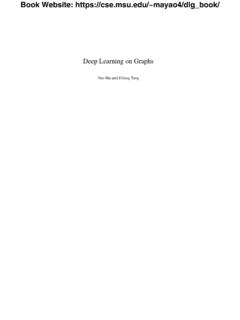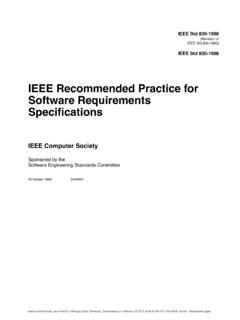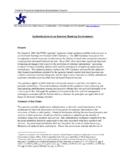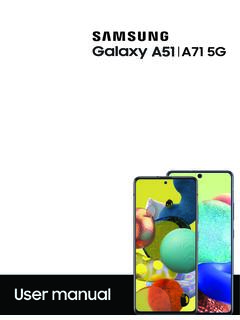Transcription of Software Requirements Specification (SRS) Book E-Commerce ...
1 Template based on IEEE Std 830-1998 for SRS. Modifications (content and ordering of information) have been made by Betty Cheng, Michigan State University (chengb at ) Software Requirements Specification (SRS) Book E-Commerce System (BECS) Authors: Andrew Blossom Derek Gebhard Steven Emelander Robert Meyer Customer: Mr. Borzoo Bonakdarpour Instructor: Prof. Betty Cheng 1 Introduction The Software Requirements Specification is designed to document and describe the agreement between the customer and the developer regarding the Specification of the Software product requested [5].
2 Its primary purpose is to provide a clear and descriptive statement of user Requirements [5] that can be used as a reference in further development of the Software system. This document is broken into a number of sections used to logically separate the Software Requirements into easily referenced parts. This Software Requirements Specification aims to describe the Functionality, External Interfaces, Attributes and Design Constraints [4] imposed on Implementation of the Software system described throughout the rest of the document.
3 Throughout the description of the Software system, the language and terminology used should unambiguous and consistent throughout the document. Purpose Defining and describing the functions and specifications of the Book E-Commerce System (BECS) is the primary goal of this Software Requirements Specification (SRS). This Software Requirements Specification illustrates, in clear terms, the system s primary uses and required functionality as specified by our customer. The intended audience of this document is our primary Book E-Commerce System customer: Mr.
4 Borzoo Bonakdarpour, the CSE435 instructor Dr. Betty Cheng, the fall semester 2007 CSE435 Group 4 members, as well as the other students attending CSE435 that will require access to such documentation. Template based on IEEE Std 830-1998 for SRS. Modifications (content and ordering of information) have been made by Betty Cheng, Michigan State University (chengb at ) Scope The Software system being produced is called Book E-Commerce System or BECS. It is being produced for a customer interested in selling books via the internet .
5 This system is designed to provide automation support [2] for the process of placing books for sale on the internet and facilitating the actual sale. This system is largely cross-platform and is available to anyone using the Computer Science Department s provided computer resources in the MSU Engineering Building. The system will be run on a central server with each user having a remote user interface through a web browser to interact with it. The Book E-Commerce System will allow any user to create an account to become a customer.
6 The customer, through the process of account creation, will have the option to become a member of the site. The system will allow customers to browse, search, select, and add books to a shopping cart. Then, provided they have books in their shopping cart, check out books in shopping cart and decrement the stock that the inventory the system maintains. The BECS also allows a manager to manage the inventory with full create, retrieve, update and delete (CRUD) functionality with regards to books in the system.
7 It will also allow, on an inventory wide basis, customers and managers to interact with a promotion system that handles percentage-off promotions that can be applied to member s orders. This interaction includes the creation (by managers) and the application to orders (by customers) of the promotions. The BECS has full email capabilities; the automated email functionality will be used to send promotions to members of the system as well as provide the managers with low-stock notifications. The BECS will have numerous constraints on what it can do.
8 The system will not have full credit-card processing capabilities. It will not allow managers to be customers. The manager will be a hard-coded user and only a single manager will exist. There will be no actual book ordering and order completion, however the system will provide the customer with a receipt and it will log the transaction details. The system will not allow multiple promotions to be added to a single shopping cart nor will it allow a customer to add more than one of each item to their cart.
9 The system also will not allow users to retrieve passwords or edit their user details. Definitions, acronyms, and abbreviations BECS Book E-Commerce System Barcode A unique identifier assigned to single items Book An instance of an Item that has these additional attributes: Title, Author Button A user interface element that allows a User to click and inform the system to take an action Checkbox A user interface element that allows a User to inform the system that he/she selected a particular item Checkout The process a Customer goes through to purchase an Item CRUD Create, Retrieve, Update.
10 Delete Customer A person that is a user of the system but has created an account Inventory An object that holds items available for purchase by the Customer Item An individual entity in the inventory which has several descriptive attributes: Template based on IEEE Std 830-1998 for SRS. Modifications (content and ordering of information) have been made by Betty Cheng, Michigan State University (chengb at ) Barcode, Price, Reorder Threshold, Stock Manager A single person that has the ability to create, retrieve, update and delete items in the store.









